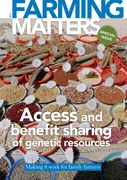Since 2012, national teams in eight countries in Asia, Africa and Latin America have been identifying options for policy, legal and administrative mechanisms for the implementation of the multilateral system of access and benefit sharing (MLS) for plant genetic resources. This article summarises if and how access and benefit sharing has been strengthened in the eight countries, and to what extent this has benefited family farmers.
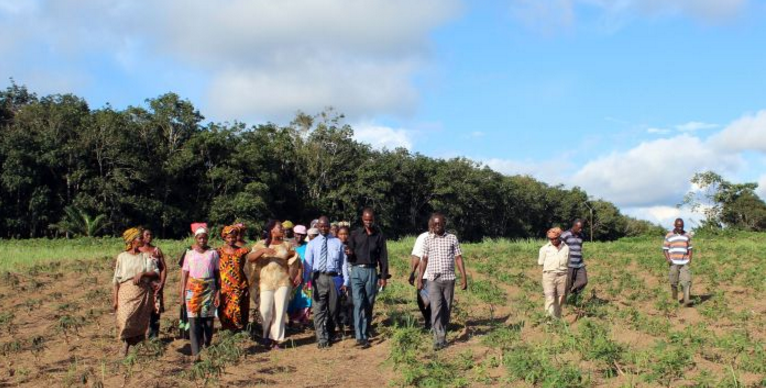
This Bioversity International-led research effort aims to increase countries’ overall participation in the multilateral system for access and benefit sharing, both as providers and recipients of plant genetic resources. Additionally, the research seeks to pursue options for the eight countries to benefit from other aspects of the Treaty, in particular technology transfers.
National research teams in Bhutan, Nepal, Burkina Faso, Côte d’Ivoire, Rwanda, Uganda, Costa Rica and Guatemala consist of the national Treaty focal point, national gene bank staff, and researchers from government and non-governmental organisations. Farmer organisations participated in some of the research activities.
The teams have conducted research on a number of topics relevant to access and benefit sharing: policy actor networks related to the national implementation of the Treaty; germplasm flows and national dependence on ‘foreign germplasm,’ particularly for climate change adaptation; linkages between the Treaty and the multilateral system (see page 10) and farmers’ management of plant genetic diversity through the lens of community seed banks, and technology transfer (as a non-monetary benefit under the Treaty). In the eight countries, the practical implementation process has followed a participatory, multi-stakeholder approach aimed at building a common understanding and broad support for implementation of the Treaty and the multilateral system. Farmer organisations participated in activities such as field research, training workshops, farmer to farmer exchanges, policy dialogues and conferences.
Paving the way for access
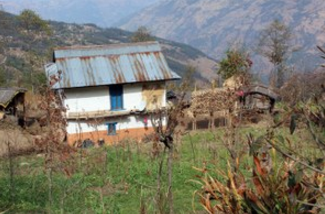
In order to prepare countries for regulatory frameworks that could help make access and benefit sharing work in practice, the teams analysed whether there was legal space for the implementation of the MLS and identified options for the revision of the relevant policies, laws, and/or other instruments when there was no legal space. They also developed draft amendments to these instruments that were subsequently introduced into the formal policy making processes of the relevant organisations and political bodies in each country. As part of this process, they clarified who in the country has authority to consider requests for access to plant genetic resources in the multilateral system (MLS) and what kind of procedures should be used. They identified the plant genetic resources in the country that are ‘under the management and control of the contracting party and in the public domain’ (as stated in the Treaty), which is a requisite to inform potential users about the germplasm included in the MLS.
This work led to concrete policy changes, such as a revision of the 2003 Biodiversity Act in Bhutan, new access and benefit sharing (draft) laws in Burkina Faso, Costa Rica, Côte d’Ivoire, Guatemala and Rwanda, a revised agrobiodiversity policy and act in Nepal, and new national environment (access to genetic resources and benefit sharing) regulations and a ‘temporary procedure’ for accessing plant genetic resources for food and agriculture in Uganda. By December 2015, Bhutan, Burkina Faso, Costa Rica, Guatemala, Nepal, Rwanda and Uganda had prepared lists of accessions to be included in the MLS and notifications sent or being prepared to be sent to the Treaty secretary. These achievements pave the way for breeders, farmers and other users to request and obtain germplasm from distant locations for the purposes defined by the Treaty.
Understanding international dependence
In the aforementioned countries we carried out additional studies about the introduction and domestication processes of key food security crops at national level – an often poorly recognised form of access and benefit sharing. This research contributed to an increased awareness of each country’s dependency on international germplasm exchanges for their agricultural development and food security. Previously, this fact was perhaps known to a handful of people through advanced studies or work experience, in particular gene bank managers and breeders.
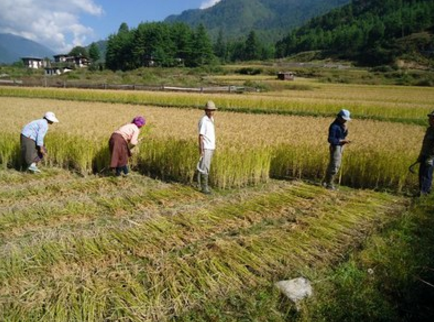
The improved rice variety developed in Nepal, Khumal-4, is a telling example. If this variety had not been developed and promoted using foreign sourced germplasm (the variety IR-28), it may have been more prone to disease and pests, and have lower yields. Thus, family farmers benefit directly from having access to germplasm that has good adaptive capacity. An estimated 70% of rice varieties released in Nepal contain genes from foreign sources, which has been highly beneficial for rice production and food security in the country. Not having access to new germplasm could result in considerable monetary and non-monetary losses for the country. We had very similar findings concerning rice cultivation in Bhutan.
The roles of community seed banks
In order to identify ways to strengthen the utility of the Treaty for family farmers, in particular through providing access to better adapted seeds, we reviewed the functions of community seed banks. A community seed bank is a form of farmer organisation closely aligned with the objectives of the Treaty. They are mostly informal institutions that are locally governed and managed that have the core function of maintaining seeds for local use. We found that community seed banks perform a broad range of functions including awareness raising and education about the importance of conserving agricultural biodiversity, documentation of traditional knowledge and information, the collection, production, distribution and exchange of seeds, and sharing of knowledge and experience. However, to date community seed banks have not benefitted directly from the Treaty and the multilateral system.
Our inventory found that community seed banks usually have a seed storage facility collectively managed by the farming community. This represents a community level ex situ facility, similar to that of a national or international gene bank. In practice, except for a few cases, community seed banks store seeds only for one season and regenerate seeds each year through various mechanisms. For example, the community seed bank in Bara, Nepal, establishes more than 80 local rice varieties in an appropriate area each year to characterise and multiply seeds for the next season. At the same time, they also distribute seeds of each local variety to one or more members on a loan basis, so that the bank has two sources of new seeds each year.
Some community seed banks are continuously working on broader issues such as empowerment of farming communities, promotion of ecological agriculture, participatory plant breeding and grassroots breeding activities, establishing farmers’ rights over seeds and development of fair community level benefit sharing mechanisms that may arise from the use of plant genetic resources, for example, through formal collaboration agreements with the national gene bank, such as the collaborations under development in Bhutan, Burkina Faso, Nepal, Rwanda and Uganda.
Community seed banks perform a broad range of functions
In Uganda, the country team decided to explore using the multilateral system to provide new germplasm to one of the community seed banks. The team used climate change scenario analysis and crop suitability modelling applied to beans (a key crop for farmers’ livelihoods) to identify bean accessions with good climate adaptation potential from three sources: (i) the national gene banks in Rwanda and Uganda, (ii) communities in both countries and (iii) international gene banks. In 2014, the first phase of participatory field trials with farmers using materials from the national gene banks and locally adapted material was realised. A total of 20 varieties were evaluated (and ranked) by farmers for climate resilience and other desirable traits. Accessions from international gene banks were obtained in 2015 through the MLS and are now being multiplied for future testing in farmers’ fields.
Technology transfer: nonmonetary benefit sharing
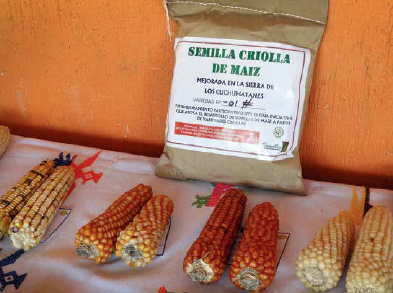
transfer. Guatemala. Photo: Gea Galluzzi
Country teams conducted studies to analyse technology transfer practices and knowledge needs related to the conservation and sustainable use of plant genetic resources. Technology transfer, as described in the Treaty, is considered to be a major non-monetary benefit to be realised through a variety of forms of international cooperation between and among actors with an interest in plant genetic resources. Experiences have been mixed, some giving satisfactory results, with some ending in failure.
If we look at Guatemala, some of the operations of five technologies generated or transferred by the Institute of Agricultural Science and Technology (ICTA) were successful, others less so. For example, the development and use of the ICTA Ligero bean variety is considered a success due to the collaboration between CIAT, a regional breeding programme (PROFRIJOL), and ICTA. Farmers are using the new bean variety widely, a result achieved through a strong network of national partnerships in which farmer organisations were a key actor. However, the hybrid maize variety ICTA MayaQPM is hardly being used by farmers for a number of reasons, including the high cost of buying seeds year after year, the variety’s susceptibility to pest and disease, and a lack of appeal to consumers.
Similarly, in Burkina Faso we found that the key factors constraining technology transfers are lack of financial means, the high cost of technologies, and weak links between farmers’ organisations and technology providers. We also found key elements for effective non-monetary benefit sharing of technologies: the capacity of farmers’ organisations to reach out to many farmers at the same time, participatory technology needs assessments, development of local fora where stakeholders involved in the concerned technology can meet and discuss needs and interests, and appropriate training and the establishment of demonstration plots around the country.
Prospects
Although significant progress in the eight countries has been made, improving access in particular, national implementation of ABS under the Treaty is still quite weak. This suggests that more support for countries with lacking implementation capacities is necessary in the coming years. In many countries, national policy makers, farmers and other agricultural stakeholders face the challenge of enhancing access and benefit sharing to genetic resources, information and technologies. They must deal with these challenges urgently in the context of the need to adapt to climate changes. The central role of family farmers must remain key in this process. One of the emerging lessons is that research and capacity building for developing policies, laws and administrative guidelines and their effective implementation are essential for improving access and benefit sharing.
Ronnie Vernooy (r.vernooy@cgiar.org) is genetic resources policy specialist, Bioversity International, Italy
Michael Halewood (m.halewood@cgiar.org) is leader of the policies, institutions and monitoring component at Bioversity International, Italy
Isabel López-Noriega (i.lopez@cgiar.org) is legal specialist at Bioversity International, Switzerland
Gloria Otieno (g.otieno@cgiar.org) is associate expert genetic resources and food security policy, Bioversity International, Uganda
Isabel Lapeña (isalapena@gmail.com) is an independent consultant based in Spain
Raymond Vodouhe (r.vodohue@cgiar.org) is genetic diversity specialist at Bioversity International
Benin Guy Bessette (gbessette3@gmail.com) is an independent consultant based in Canada

